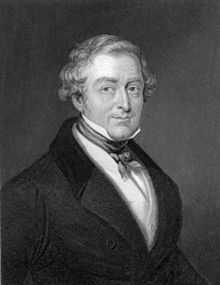Thomas de Grey, 2nd Earl de Grey
| The Right Honourable The Earl de Grey KG PC FRS | |
|---|---|
 | |
| The Earl de Grey. Sketch by Jean Auguste Dominique Ingres, 1816. | |
| First Lord of the Admiralty | |
| In office 22 December 1834 – 8 April 1835 | |
| Monarch | William IV |
| Prime Minister | Sir Robert Peel, Bt |
| Preceded by | The Lord Auckland |
| Succeeded by | The Lord Auckland |
| Lord Lieutenant of Ireland | |
| In office 11 September 1841 – 17 July 1844 | |
| Monarch | Queen Victoria |
| Prime Minister | Sir Robert Peel, Bt |
| Preceded by | Viscount Ebrington |
| Succeeded by | The Lord Heytesbury |
| Personal details | |
| Born | 8 December 1781 |
| Died | 14 November 1859 |
| Nationality | British |
| Political party | Tory |
| Spouse(s) | Lady Henrietta Cole (d. 1848) |
| Alma mater | St John's College, Cambridge |
Thomas Philip de Grey, 2nd Earl de Grey, 3rd Baron Grantham and 6th Baron Lucas KG, PC, FRS (8 December 1781 – 14 November 1859), known as The Lord Grantham from 1786 to 1833, was a British Tory politician and statesman of the 19th century. Born Thomas Philip Robinson, his surname was Weddell from 1803 and de Grey from 1833.
Background and education
de Grey was the eldest son of Thomas Robinson, 2nd Baron Grantham and his wife, Mary, a daughter of the Jemima Yorke, 2nd Marchioness Grey and younger sister of the Amabel Hume-Campbell, 1st Countess de Grey. Prime Minister Lord Goderich was his younger brother. He succeeded his father as third baron in 1786, and became the sixth baronet Robinson of Newby in 1792. In 1833 he succeeded his aunt as second Earl de Grey according to a special remainder and also inherited the Wrest Park estate in Silsoe, Bedfordshire. In 1798 he was admitted to St John's College, Cambridge, graduating MA in 1801.[1] He became second Earl de Grey and Baron Lucas of Crudwell in 1833.
Political career
He was made Privy Counsellor in December 1834 while holding office as first Lord of the Admiralty till April 1835, and a Knight of the Garter in 1844. He was colonel-commandant of the Yorkshire Hussar Regiment of Cavalry for over forty years and was appointed yeomanry aide-de-camp to William IV and held similar position under Queen Victoria. Thomas de Grey was nominated as Lord Lieutenant of Bedfordshire in 1818, an office which he held until his death. He served as Lord Lieutenant of Ireland from September 1841 to July 1844. During his time in Ireland he disagreed with Peel's religious conciliation of Ireland, claiming that economic conciliation was a greater priority.[2] He called for more legislation focused on Ireland whilst Peel pursued economic legislation aimed at benefitting the UK as a whole.[3]
Other public positions
On the founding of the Institute of British Architects in London in 1834 he was invited to become its first president remaining so till his death in 1859. The institute received its Royal Charter in 1837 becoming Royal Institute of British Architects in London. Earl de Grey was also a fellow of the Royal Society, a fellow of the Society of Antiquaries, and served as one of the New Buckingham Palace Commissioners from 1848. Besides remodelling his London home at No.4 St James's Square (now the Naval & Military Club) he designed the new Wrest House inspired by French architecture at his Wrest Park estate in Bedfordshire between February 1833 and October 1839, assisted by James Clephan, and maintained the Park adding a number of decorations and statues.
Family
Lord de Grey married Lady Henrietta, daughter of William Cole, 1st Earl of Enniskillen, in 1805. They had two daughters - Ann Florence and Mary Gertrude. His wife Henrietta died in 1848. Lord de Grey survived her by eleven years and died in November 1859, aged 77.
He was succeeded in the barony of Lucas of Crudwell by his daughter, Ann, who was Countess Cowper by marriage, as well as Baroness Lucas in her own right.
His other titles passed to his nephew, George Robinson, 2nd Earl of Ripon.
See also
References
- ↑ "Grantham, Lord Thomas Philip (GRNN798TP)". A Cambridge Alumni Database. University of Cambridge.
- ↑ C. Read, 'Peel, De Grey and Irish Policy 1841-44' History, January 2014, pp1-18.
- ↑ Ibid.
- The Earl de Grey’s account of the building of Wrest House, History of Wrest House, introduction by A. F. Cirket, The Bedfordshire Historical Record Society, Volume 59, pp 65–87, Bedford 1980
- Earl de Grey, Charles Read, London 2007
- Leigh Rayment's Peerage Pages
| Honorary titles | ||
|---|---|---|
| Preceded by The Earl of Upper Ossory |
Lord Lieutenant of Bedfordshire 1818–1859 |
Succeeded by The Duke of Bedford |
| Political offices | ||
| Preceded by The Lord Auckland |
First Lord of the Admiralty 1834–1835 |
Succeeded by The Lord Auckland |
| Preceded by Viscount Ebrington |
Lord Lieutenant of Ireland 1841–1844 |
Succeeded by The Lord Heytesbury |
| Peerage of the United Kingdom | ||
| Preceded by Amabel Hume-Campbell |
Earl de Grey 1833–1859 |
Succeeded by George Robinson |
| Peerage of England | ||
| Preceded by Amabel Hume-Campbell |
Baron Lucas of Crudwell 1833–1859 |
Succeeded by Anne Cowper |
| Peerage of Great Britain | ||
| Preceded by Thomas Robinson |
Baron Grantham 1786–1859 |
Succeeded by George Robinson |
| Baronetage of England | ||
| Preceded by Norton Robinson |
Baronet (of Newby) 1792–1859 |
Succeeded by George Robinson |
|
